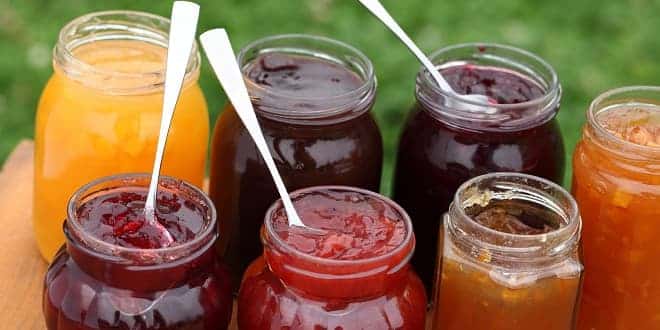Pectin
Pectin
Occurs in plant middle lamella
Gel former, e.g., fruit jelly
From the Greek word meaning tto congeal
Pectin was discovered in 1790 by Vauquelin and later (1825) crudely characterized by Braconnot O Pectic Substance Nomenclature
Protopectin-high methyl ester content
Pectinic acid-intermediate methyl ester contentcontent, solublesoluble – Salts are pectinates
Pectin-intermediate methyl ester content, colloidal
Pectic Acid-little methyl ester content – Salts are pectates
Pectin–Chemical structure Some other sugars, mainly L-rhamnose, are also present O Pectin structure Other monosaccharides (L-rhamnose, L- arabinose, D-xylose) in the structure may limit the size of junctions zones that can bbe fformedd andd, ththus, att lleastt partitialllly determine ultimate gel strength O Carboxyl Substitution in Pectin Degree of Methoxylation (DM) – Protopectin 16% – NormalNormal pectinpectin 8%8% – Low Methoxyl Pectin 2-4% Degree of Esterification – Protopectin 100% – Normal Pectin 50% – Low Methoxyl Pectin 12.5-25%
High and low methoxyl pectins If DE is greater than 50%, it is a high methoxyl pectin (HM pectin) If the DE is less than 50%, it is a low methoxyl pectin (LM pectin) O Degree of amidation (DA) The DA value indicates the percentage of carboxyl groups that nave been converted to the amide form by ammonia processiingAmidated LM pectins may have a DA of 15-25% Amidated pectins are especially sensitive to Ca+2 (see W&B, Figure 13.5) O Types of pectins HM LM Amidated LM -COOCH3 -COOCH3 -COOCH3 ((>> 50%)50%) ((<< 50%)50%) ((<< 50%)50%) -COOH -COOH -COOH – + – + – + -COO Na -COO Na -COO Na -CONH2 (15-25%)
Pectic Substances and Gelation Normal Pectin – Gels in the presence of acid and sugar Low Methoxyyl Pectin – Doesn’t need sugar, but does need calcium ion Pectic Acid – Forms insoluble calcium pectate. This reaction is responsible for the firming effect seen in certain plant tissues, e.g., canned tomatoes O Pectin gels Atomic force microscopy image courtesy of Peter Cooke, ERRC, ARS, USDA O Chemistry of pectic substances Me O H O O O H O dilute acid O O O O O oror basebase O O H O O H H H dilute acid depolymerization high temperature
Commercial (Normal) Pectin Liquid or powdered Source — mostly lemon and lime peel (20-30% ppectin)). This is the higghest qqualityy. Some from apple pomace (10-15% pectin) Pectin grade = number of pounds of sugar that one pound of pectin can carry in a jelly O Pectin production Citrus peel is extracted at pH 1.5-3.0 and 60-100oC Extract is filtered Pectin is precipitated by addition of isopropanol O Commercial (Normal) Pectin Grade is influenced by DE and molecular weight Gel strength — measured by ridgelimeter (measures(measures %% sag)sag), penetrometerpenetrometer, InstronInstron, oror texture analyzer.
Low methoxyl pectin Available commercially Requires no sugar to gel Reqquires calcium ion to ggel Preparation Enzyme, acid, alkali – Pectin LM Pectin – Acid preparation is best, produces firmer gels – Enzyme preparation is inferior as demethylation is not random O Low methoxyl pectin Range of pH for gel formation = 2.5-6.5 O Pectin uses Principally used in jellies and jam However, some is used in – Confections – Beverages – Acidified drinks See W&B, Table 13.2 for other uses of pectins
Jelly making Need — pectin + acid + sugar Pectin – 0.5-1.0% – If juice is low in pectin, may concentrate by boiling or add more as commercial pectin – Peach — poor gel, pectin contains acetyl groups – Citrus — forms a good gel O Jelly making Acid – Contributes flavor – pH optimum is 3.2 – If juice is low in acid, add lemon juice O Jelly making Sugar – Preservative – Micororganisms cannot grow due to the jjelllly’’s hihighh osmotiic pressure – Optimum sugar concentration is about 65% soluble solids
Jelly making Sugar – This is reflected in the final cooking temperature (colligative properties) of 104.5o CC – During this cooking some of the sucrose is hydrolyzed to invert sugar which will discourage sugar crystallization in the jelly O Gel strength in normal pectin jellies Jelly strength Continuity of Rigidity of structure structure [Pectin] Optimum is Acidity [Sugar] about 1% Optimum is 3.2 Optimum 65% Low-hard gel Low-weak gel High-no gel High-crystals form O Setting times HM pectins DE Setting time Rapid set 72-75% 20-70 sec Medium set 68-71% — Slow set 62-68% 180-250 sec
Setting times Rapid set pectins are used in jams where quick gelling is desired to prevent flotation of the fruit Slow set pectins are used in jellies to provide time for bubbles to escape High methoxyl pectin gels can not usually be melted and reformed O Theory of normal pectin gel formation A pectin junction zone Hydrogen bonds O Pectin junction zones O OH O O CH3 H OH H OH HO H O H H O O H H OH OH H OH H H OH H H OH H H O O H H O H O H H O CH 33 HH OOHH HH OO OO O OH H O O H O CH H OH HO O 3 H O H O H H O O H OH H OH H OH H H H H OH H HO O H H O O H H OH CH H OH CH O O 3 O O 3 H OH
Theory of low methoxyl pectin gel formation CCallciium iion Ionic bonds O LMP junction zones H CH O OH 3 H O H OH O O H O H O H H O O H OH H OH H OH H H H H OH H HO O H H O O H H OH H OH O O- O O- H OH 2+ Ca 2+ Ca – O O – O O H OH H OH HO H O H H O O H H OH OH H OHH H OHH H OH H H O O H H O H O H H O CH 3 H OH H O O O O CH 3 O Theory of low methoxyl pectin gel formation – pH needs to be higher (3.2-4.0) because only carboxylate (COO-) groups can participate in these types of ionic bonds
Methyl ester content and gelling ability 2 + a C h t i ww l e g o t y t i l i b A 0 20 40 60 80 100 DE O Characteristics and uses of low methoxyl pectin gels – These gels can be melted and reformed repeatedly – No sugar is needed to form the gel, hence thesethese typestypes ofof pectinspectins areare usedused inin dieteticdietetic products. In practice, a small amount of sugar is left in the dietetic products as a tenderizer/texturizer. When included in these preparations, the resulting jellies are not as brittle as they would be in the absence of the sugar. O Uses of low methoxyl pectin gels Fat mimetic – From Hercules, this is a LM pectin gelled with Ca+2 and microparticulated (particle sizesize << 11 μμm)m) – Trade name is Slendid
9/23/2008 O Labeling Both HM and LM pectin may be labeled pectin
…




